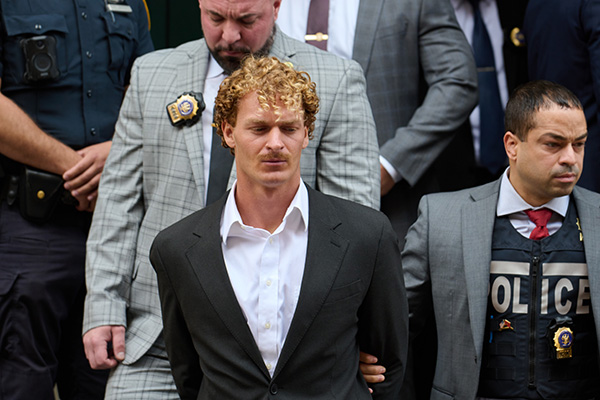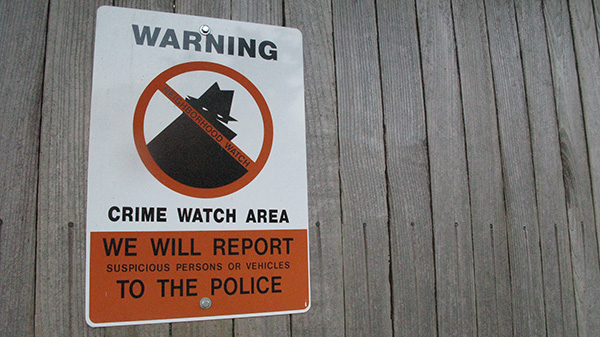The Urban ‘Doom Loop’
Joseph Kay, American Renaissance, October 6, 2023

Credit Image: © Richard B. Levine/Levine Roberts via ZUMA Press
Subscribe to future audio versions of AmRen articles here.
American cities are in a “Doom Loop.” Quality of life collapses, residents flee or stay home, and cities fall into economic decline. As the economy falters, even more locals flee, and the cycle repeats. Cities may stabilize into something like Detroit or St. Louis.
Crime is central to the decline, but newspaper headlines and statistics don’t capture it. Statistics may not even be credible, because crime can be “eliminated” by misclassifying it or not enforcing the law. Less obvious but more consequential in the long run, is fear of crime. This fear is especially common in cities with significant black populations, even though the actual proportion of blacks may be small.
The appearance of a predator triggers the brain’s amygdala, which activates the flight-or-fight mechanism. The brain shifts into hyper-alert mode, heart rate and blood pressure rise, glucose flows to skeletal muscles, and non-essential bodily functions such as digestion slow down. This fear is involuntary and thus unaffected by TV commercials about happy blacks and whites folding laundry together. Mother Nature knows the score: blacks are dangerous. Moreover, unlike officially recorded crimes, fear of crime is a regular, inescapable, and unpredictable part of urban life.
Fear is purely psychological and personal and therefore falls outside the statistical record. It is real, though, and has many causes: drugged-out “crazies” wandering the streets, disheveled vagrants sleeping in subways and on park benches, armies of aggressive panhandlers, mentally ill people talking to themselves, public drug markets, the smell of marijuana in the air. Exacerbating the fear is the knowledge that many such people are on violence-inducing drugs, such as crack or fentanyl. We are light-years away from the time when a city’s deranged were just drunk on cheap wine and usually harmless.
Threats are often unexpected, such as self-proclaimed “doormen” at McDonald’s with plastic begging cups. Like night creatures, threats emerge after dark in New York City’s Grand Central Station and even at airports.
The “homeless” are especially disturbing. New York City still lacks huge California-style encampments, but it has plenty of horrific-looking men living on the street, even in busy shopping districts.
Particularly notable are black men who look like mugshots of rapists and murderers. They favor elaborate dreadlock hair styles so weird that they hint at an underlying mental condition. Add an angry scowl, pristine expensive sneakers, and a hoodie, and the ensemble is complete.
There is always the potential for something truly bad. Visceral reactions tell the truth. What happens if the obviously deranged paranoid on the subway platform looks you in the eye and goes bonkers? Even a crowded street is no protection, since the assailant is unlikely to worry about being caught and can hurt you in a millisecond.
Compounding this dread is the ever-diminishing prospect of help from bystanders or even the police. High-profile incidents such as the arrest of would-be Good Samaritan Daniel Penny when he intervened to stop a likely felony-in-progress in the subway are a powerful deterrent, not to mention hesitant police officers in the post-George Floyd era. You’re on your own.

Daniel Penny, ex-marine who placed Jordan Neely in a chokehold on the subway leading to his death, turns himself into the NYPD 5th Precinct. (Credit Image: © Edna Leshowitz/ZUMA Press Wire)
The statistical odds of any one encounter becoming a criminal incident are very low, but any city resident has a great many chances to be afraid. A typical subway commute from Queens to Midtown Manhattan (which may include walking several blocks) plus going out for lunch means many encounters. Multiply by five days a week, and fear becomes part of city life.
Ironically, anti-crime measures may increase fear. It can be a shock to visit a local drug store and find freshly installed locked glass cabinets and empty shelves cleaned out by shoplifters. What can a sane person think when Walgreens puts Tide under lock and key? No wonder businesses struggle to get employees to come into offices.
Middle-class white women are perfect victims — they typically have something worth stealing, are almost never armed, are incapable of defending themselves, and are easy to pick out of a crowd.
Fears can be quelled. First, lock up the bad guys. No one should ever read about a killer picked up by the police with 66 prior arrests.
Other measures are more subtle. Loitering laws used to civilize cities. They made it a crime just to stand around, either while drunk or begging or in anticipation of selling drugs or turning a trick. When the police arrest loiterers, they don’t have to wait until miscreants run out of Nordstroms with armfuls of pocketbooks. They can collar them preemptively.
Loitering laws control crime. In the past, an unwritten rule was that people could break the law only in well-defined places, beyond the sight of respectable society. Public drunkenness was tolerated only on skid row or in seedy waterfront bars. Prostitution was permitted only in well-defined red-light districts. “Cruising” gays had to move to unofficially tolerated gay bars. Cities had well-known “good” and “bad” neighborhoods, and civil society flourished.
Laws against public nuisances are another bulwark against the Doom Loop. Laws vary, but their intent is to criminalize interfering with the rights of the public. The California version makes it illegal to do anything that is “an obstruction to the free use of property, so as to interfere with the comfortable enjoyment of life or property by an entire community or neighborhood . . . or unlawfully obstructs . . . free passage or use. . . .” A bum encampment on the sidewalk or in a park is a clear violation.
A third solution is vigilantism. Some forms of vigilantism are still legal in some states (citizen’s arrest). The tradition of people handling public problems themselves goes back to Biblical times. Ironically, the term “vigilante” originated in San Francisco. The San Francisco Committee of Vigilance was set up in 1851 to control gang violence, and it worked.
American vigilante justice has often succeeded, and imposing it is easy. Cities typically have business associations that hire real security, not the toothless rent-a-cops who stand by watching shoplifters. The successful Crime Watch Program of the National Sheriff’s Association helps neighborhoods monitor unwelcome visitors and report them to the police. Sometimes even otherwise criminal groups, such as the Italian Mafia, protected the streets of New York’s Little Italy during crime waves.

Credit: daveiam via Flickr, CC BY 2.0 DEED
Unlike utopian “solutions,” such as building affordable housing or curing mental illness, these measures work. Why aren’t they used? These preferred “solutions” are just tactics to escape the reality that much of the Doom Loop is rooted in race. Ignoring race invites paralysis or foolish PR campaigns to attract tourists to dystopic San Francisco. In today’s ideological landscape, any anti-crime measure, let alone private vigilantism, that disproportionally punishes blacks is DOA. Enforcing loitering laws would mean massive incarceration of blacks at a time when emptying prisons is official policy.
Reversing the Doom Loop is not about housing policy or mental health counseling, and like so many other threats to civilization, it is largely about race. Cities can’t defend themselves — even from horrific consequences — if they refuse to take measures that look “racist.” We now live in a world where ending “over policing” has replaced “broken windows” policing.
Politicians would rather not jail “too many blacks,” even if that means destroying their cities. Given a choice between degeneracy and enforcing time-honored, constitutional, quality-of-life laws, public officials choose the former. This is more than foolish. It’s an attempt to reverse human nature, to suppress our hard-wired, healthy reactions to physical threat — all in the name of some far-fetched racial utopia. People will move away. The ones who stay won’t go out. Countless businesses will go bankrupt. But the jails will never be filled with blacks.
Reversing the Doom Loop is about defending civilization. The United States spends billions on exotic high-tech weapons to defend against foreign enemies but refuses to let police stop bands of “youths” headed to Nordstrom to steal Gucci handbags. We now have a Space Force, but elected leaders won’t let Walmart stop shoplifters. Stopping the Doom Loop is not about therapy for crazies or homes for winos; it is about therapy for those who refuse to defend their own civilization.















